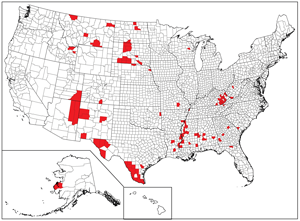The per capita income in Allen is $1,539. It would not be hard for me to blow through that money in a weekend. In fact, when my car needed repairs, I did. The median income for males in Allen is $0.
Wanblee is 59th on the list, with almost three times the per capita income of Allen. Fourteen other towns in South Dakota make the top 100, all of which are on or near reservations. The rest of the list is filled with other reservation towns in other states, border towns in Texas, and scattered rural communities across the country. A map of the country's poorest county's makes this pattern clear: Rez towns, border towns, Appalachia, Mississippi Delta--and then just a few scattered outliers. (Shannon County, the bulk of Pine Ridge Reservation is the 2nd poorest county; Todd County, which comprises the Rosebud Reservation, is number 5; Jackson County, where I live, is number 23--though half lies off the reservation. Five of the ten poorest counties are in South Dakota.)

The smallest town on the list has a population of seven (it's in South Dakota!); only one town has more than 10,000 people--and its over twice the size of the second largest community on the list. That rural places dominate the list is no real surprise: I'm sure there are seven people clustered in every major city that have a per capita income less than Aurora Center's ($4,700), but they do not have the distinction of forming their own town, and therefore their own census designated place.
But to discredit these rural people is unfair. I live smack dab in the middle of a red patch above; I would have to drive seventy miles to make it out. And I'm lucky that I can make that drive. Most people here can't. And we're lucky that we have a high school here, not just for the education, but for the jobs: what sets us apart from Allen, and from Wounded Knee, and Parmelee, and Porcupine, and all the other towns I know of just a little below us on the list, is that we have a high school, and therefore a few more jobs, and therefore a few more dollars. But plenty are left jobless, with few models of success available. Unlike the city, there is no starkly different life just a few miles away--only more poverty.
What is striking to me, though, is how little I notice it all. I live in teacher housing; my neighbors, like me, are the lucky few with jobs. I rarely have business in Old Housing, across the highway, and so rarely pass through it. People come by my house selling all kinds of items--dreamcatchers, kittens, elk antlers, government commodities, or even just asking for gas money--but not for their intrusion, I could pretend I lived in some other small town, struggling but fine. I have satellite television. I have wireless internet. I have organic peanut butter--I have kale from the poorest place in America. And I still, after two years, have very little idea what lives my students are living.
1 comment:
Very good post. I live on the Sisseton-Wahpeton reservation, and compare to these aforementioned reservations, we are living the good life. Very informative, thanks for posting!
Post a Comment